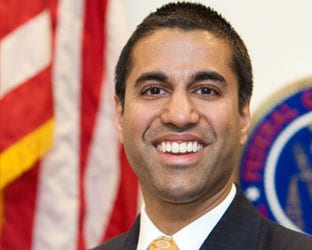When it comes to the FCC, Chairman Ajit Pai has found inspiration in one of the most iconic play-by-play sports announcers the broadcast world has ever seen: Vin Scully.
Speaking Tuesday morning (4/25) to a capacity crowd that resulted in a last-minute scramble to provide a video stream of Pai’s speech to dozens of individuals shut out of the Las Vegas Convention Center North Hall room where the Chairman held court, the affable leader and avid sports fan recalled Scully’s call of Kirk Gibson’s “improbable” home run to win Game 1 of the 1988 World Series for the home Los Angeles Dodgers.
Noting that Scully offered one sentence to tell people what had just happened, and then offered 1 minute and 10 seconds of silence to let the crowd’s roar tell the story, Pai believes this serves as a perfect analogy for how the FCC should regulate the broadcast – and cable – television and radio industries.
“There’s nothing better than the roar of America’s communications engine,” Pai said. “So long as I have the privilege of serving as FCC Chairman, you can be sure that I’ll do my best to get unnecessary rules out of the way so that broadcasters can rev that engine.”
At a colossally large conference with much of the action and activity in the Central Hall – where the tech players are, as opposed to the North Hall with a lighter flow of attendees checking out radio and TV tech firms’ exhibit booths – Pai began his address by talking about radio.
“I remain fundamentally optimistic about the future of broadcasting,” Pai said. “For starters, there is abundant evidence that broadcasters are continuing to thrive in the internet age.”
That’s when he noted that, each week, some 93% of Americans still listen to the radio – the same as a decade ago, and a decade before that, and a decade before that, Pai said.
Why is he so bullish on radio? “Broadcasting’s strengths—its values—are timeless.”
That comes down to localism, diversity, and public service.
He also said Americans will always need journalists to handle investigative reporting in their communities, “to keep local leaders honest.” That, of course, would require a conversation about newspapers and their shaky overall health.
In this case, Pai turned toward TV, and its role in bridging communities by creating moments – like having the wrong winner being announced at an awards show — and delivering important information should a disaster strike.
“That’s why I believe we will always need broadcasters,” Pai said, noting that local content has thrived in recent years.
“The average amount of local news programming aired by commercial television stations has increased by more than 40% since 2004,” he added. “This didn’t occur because of government mandates. It occurred because broadcasters responded to consumer demand and competitive pressures. I don’t see the free market as the enemy of localism. To the contrary, I see them as entirely compatible.”
So, where does the FCC fit into the broadcast industry’s future?
By making sure its rules match 2017, not 1997, Pai said.
“The last thing broadcasting, or any industry for that matter, needs is outdated regulations standing in its way,” Pai said. That’s particularly true with the swiftly changing broadcasting industry, and why he wants the FCC to work “aggressively” to modernize Commission rules and reduce the red tape.
“Broadcasting remains an indispensable part of America’s communications landscape, and under my chairmanship, broadcasting won’t been seen as a speed bump,” Pai said, adding that the FCC “should promote innovation in the broadcasting business, not stand in the way of progress.”
As of today, Pai said, “there are close to 1,000 pages of media regulations on the books, many of them decades old. Well, I’m trying to change that.”
MEDIA REGULATIONS TO GET COMPREHENSIVE REVIEW
At the FCC’s May Open Meeting, on May 18, the Commission will start a wide-ranging review of its media regulations, to best see which rules are still necessary and which should be relaxed or repealed.
The first regulation set for modernization? The main studio rule, first adopted before World War II.
“It seems to me that technological innovations have rendered local studios unnecessary,” Pai said.
Pai’s plan to launch a Public Notice to review cable and broadcast regulations “with an eye toward eliminating unnecessary ones” was immediately met with praise by American Cable Association President/CEO Matthew M. Polka.
“ACA agrees with Chairman Pai that the time is now for the agency to comb through cable and broadcasting regulations in search of rules that are out of step with current market conditions and are no longer necessary to serve the public interest,” Polka said.
He added that the ACA looks forward to filing comments and “offering specific, data-backed recommendations and guidance that the FCC can use to ensure that smaller video providers can devote their limited time and capital to investments in their networks, rather than complying with outdated regulations.”
With some discussion on AM translators (see our related story), Pai concluded his address by ensuring that the post-spectrum auction repack be “smooth and efficient.” The FCC’s chief task is protecting stations from going dark, and called on the TV broadcast industry to work with the Commission to get the work done right.
Pai hopes there will be a new spirit of cooperation between the Commission and the broadcast industry. “We’re already working to foster greater cooperation,” he said. “I hope there will be a new spirit of cooperation among us … even when we don’t agree, at least you know what I believe and where I stand. You have my word that this FCC will go wherever the facts and the law lead us. In return, I would ask that you keep an open mind and apply a presumption of good faith to the decisions we make.”
RBR + TVBR




